A tablecloth is one of the most important elements in table setting, capable of transforming an ordinary atmosphere into a festive one in a matter of minutes and creating a festive atmosphere in the room. In addition to its aesthetically attractive appearance, the tablecloth must be practical; the fabric must be easy to wash and durable.


The modern textile market is overflowing with various exclusive offers, but often with a chic selection of goods it turns out that there is simply nothing to focus on. Either the design is not suitable, or the pattern is not harmonious, or the quality of the fabric is such that during the first wash, the entire chic ornament may disappear.
Today, housewives are becoming more and more involved in needlework due to fashion trends. Homemade hand-made has been relevant for several years and has not lost its popularity.
What type of tablecloth is there?
If the kitchen renovation has already been completed and its design adheres to a certain style, it is difficult to choose a suitable tablecloth for a festive or everyday table. The conclusion in this situation is clear: the option that you develop yourself will ideally complement your kitchen. You can sew the most unusual tablecloth with your own hands and decorate a festive table with it if you have basic sewing skills, which are included in the school curriculum.

Before you pick up cutter's scissors and start sewing a tablecloth with your own hands, you should determine for yourself what exactly you want, because There are several types of tablecloths:
- Casual tablecloth. This type performs the main function of protecting the table from mechanical damage. To sew it, you should choose inexpensive, durable fabric. A material with a Teflon coating is ideal, as it protects the fabric from moisture, resists chemical influences, and is non-stick. Oilcloth tablecloths, sewn by yourself, are easy to clean, are not afraid of hot surfaces and do not allow moisture to pass through.
- Camping tablecloth. These tablecloths are taken with you to country picnics or outdoors. Their main purpose is to protect products from dirt and insects, so it is better to sew them from thick, practical fabrics.
- Festive tablecloth. To sew such a tablecloth, you can choose any, even the most unusual, materials that suit your taste. The main function of a festive tablecloth is to decorate the table; thin fabric decorated with ribbons, ruffles, bows, etc. can be quite suitable for it.
- Decorative tablecloth. The main function of a decorative tablecloth is to decorate any table - both a tea or coffee table, and a dining table. To sew it, you can choose any fabric you like; voluminous appliqués, bows, ruffles, rhinestones, and embroidery would be very appropriate. You can decorate it with your own hands using any decorative items.
A tablecloth on a festive table is the main accessory that attracts the attention of guests.
Tools and materials
Depending on the type of tablecloth chosen, the following tools will be needed:
- Cutting scissors;
- Fabric (one or more types);
- Needle, sewing machine with overlock;
- A thread;
- A simple pencil, chalk or soap;
- Tailor's ruler, square;
- Drawing pin;
- Thick thread or rope;
- Whatman paper or any large thick paper.
A pushpin, a rope and a writing object will be needed if you need to cut out a round tablecloth.
The choice of the shape of the future tablecloth directly depends on the shape of your table top. The design of the tablecloth can be simple with a hem seam, with edged seams, with lace, with appliqué, with a closed or open cut. An additional decorative element can be hemstitching, braid, tassels, lambrequins.
Sewing a tablecloth with your own hands for a round table



There are two ways to decorate a round table with a tablecloth:
- Big circle. In order to sew a tablecloth of a round shape, falling down to form folds, it is necessary to measure the diameter of the tabletop and determine how long the future tablecloth should be. When cutting the material, you must remember about hem allowances of 2 - 3 cm. It is better to cut the fabric according to the pattern. To do this, cut out a quarter of a circle from whatman paper or any large thick paper with a radius corresponding to the tablecloth. It is necessary to trace the pattern on the fabric folded in four from the wrong side. It is better to secure types of fabric containing sliding fibers with needles in the bending areas so that the workpiece can be cut evenly. The edges of the fabric must be overlaid, folded and stitched. The decor and decoration of the tablecloth is done at your discretion.
- A circle around the diameter of the table with sewn folds. The second method is more complicated: this tablecloth will consist of two parts - a base the size of the tabletop and fabric with folds sewn to it. The edges of the round base cut out from the pattern must be overlaid. For folds, a strip of fabric is cut out, the width of which will correspond to the length of the tablecloth, and the length will correspond to the frequency and number of folds. The minimum width of the strip should be at least 30 cm, the length should be two or even three times the circumference. One side of the strip is processed with an overlocker, the other is hemmed. The pleats can be made as a gather or in the traditional way.
Tablecloth for an oval table

The process of sewing a tablecloth for an oval table with your own hands is very similar to making a tablecloth for a round tabletop, but there are also differences. In general it looks like this:
- The paper pattern is prepared according to the full size of the tabletop; along the edges you need to add an overhang of 30 - 40 cm.
- The tablecloth is cut using a pattern folded in four from fabric folded in four. When cutting out the workpiece, do not forget about seam allowances.
- The cut pieces are processed with an overlocker and hemmed.
In order for the tablecloth on a round or oval table to hang down as much as possible and drape well, you can sew a weight cord into the hem.
A tablecloth for a rectangular table is made in the same way. A festive tablecloth can additionally be decorated with lambrequins, bows, ruffles, tassels, fringe - depending on the type of fabric.
Nowadays, even for the kitchen table, choosing a suitable tablecloth is quite problematic. While you can sew this design element with your own hands, which will fit perfectly into the interior of a new kitchen or dining room.
Without a doubt, a beautiful, neat tablecloth for the kitchen is a pleasant component of any gathering, helping the hostess teach her culinary skills to both household members and guests. It is important to choose the right tablecloth for the dining table.
Size matters
There are generally accepted rules and conditions for setting a table with a tablecloth, which state that the fabric should not only cover the surface, but also hang slightly from all sides. It happens that it completely hides the supporting parts. When choosing a covering, you need to take into account the size of the table and the reason for the celebration.
- if normal daily use is expected, the fabric hangs a maximum of 20 centimeters;
- a more significant feast - 30 centimeters;
- an official reception, banquet, wedding requires the presence of a large tablecloth hanging 40 centimeters;
- at a formal buffet table, they completely cover the table legs.















The photo of the tablecloth for the table shows the most popular version of a rectangular cloth, the sides of which can be different or the same length. They cover both square and oval tabletops.

- Rectangular surface. To begin with, it is recommended to measure the length and width of the table, adding to the resulting figures the possible allowance at the edges. Then we multiply the result by two.
- A tablecloth for a round table involves measuring the diameter of the surface, then adding twice the length of the edge that will hang from the edges.
- Oval or round tablecloths are also gaining popularity among consumers. Lying perfectly flat on the tabletop, the product forms beautiful soft folds. The size of the canvas is determined similarly to the first option with an allowance of double length.
- If you plan to cover a square tabletop, you should still measure the diagonal. It would be correct if the diagonal is smaller than the selected product, then the corners of the table will not be visible from under the textiles.















Oval tabletop: coating rules
Most often, a round table is folded out to increase the free space, so it is recommended to choose an oval cover or a rectangular universal product. The calculation is carried out using the following method:
- the diameters of the tabletop are measured (large and small);
- to each figure is added the double value of the free edge, which, of course, corresponds to the event;
- the required dimensions for the oval coating element are obtained.

Generally accepted standards
When choosing the most suitable option, you need to consider several nuances:
- textile markets and shops usually offer tablecloths of medium standard sizes. So, it is better to take a larger one so as not to make a mistake in the choice;
- It is appropriate to cover non-standard pieces of furniture (tables and chairs) with a cloth, the edge of which hangs below the level of the legs and seats;
- beautiful sets with fluffy “skirts” are sold for buffets and banquets;
- for sliding furniture, it is better to buy two tablecloths at once;
- The size of the finished product directly depends on the degree of possible shrinkage during washing, so you should slightly increase the length values.

Fabric selection
The service life of a kitchen tablecloth directly depends on the quality and practicality of the material for its manufacture. For this reason, you should first pay attention to this factor.

Most often, kitchen linens are divided into two types:
- Daily ones (for every day) are made from more affordable and practical raw materials, usually equipped with moisture-resistant Teflon or acrylic compounds. They serve as decoration, beneficially complementing the interior and style of the kitchen space. It is better if the fabric does not wrinkle and is easy to care for.
- More elegant festive elements are decorated with additional accessories, used exclusively for special events. There are products with a themed theme: Christmas, Easter, birthday, children's party or wedding celebration.









Fabric for daily use offers functionality and increased performance. Here are the most popular options:

Since ancient times, oilcloth has been a popular covering without being a textile. You can buy both transparent and thick tablecloths from oilcloth. Visually, it is not entirely aesthetic, but it perfectly protects the surface from everyday stains, damage and dirt. Moreover, this is a cheaper budget option that saves the family budget.

Practical and relatively cheap polyester, unlike oilcloth, has a more interesting and varied design. The exterior is decorated with patterns and ornaments. The material is easy to wash, clean from dirt, does not wrinkle and is quite suitable for serving for every day, fitting into any style.

The soft folds of cascading cotton make the table an incredibly cozy feature. The kitchen is supplied with cotton material impregnated with a special water-repellent composition, which protects it from stains and damage. The fabric is easy and convenient to wash in warm water and place hot dishes on it. Please note that frequent washing leads to rapid thinning of the threads and wear of the raw materials.

Currently, silicone tablecloths are gaining popularity, being an excellent replacement for traditional textiles. The coating protects the tabletop well from mechanical damage and contamination, keeping the furniture in perfect condition. But, usually, it is used not for decoration, but for practical purposes.

Photo of tablecloth on the table




















A table covered with a beautiful tablecloth is the basis of a pleasant feast, which really helps the hostess to charm guests and household members with her culinary skills. How to choose the right size tablecloth for the dining table? Find out all the details here!
Choosing the right tablecloth according to size
In accordance with the accepted rules for table setting, any tablecloth should not just cover the table, but hang slightly from it, covering the side of the table or even its legs. Therefore, the required size of the tablecloth is selected not only according to the size of the table, but also in accordance with the reason for the feast.So, the tablecloth should hang over the edge of the table:
- for everyday use - by 15-20 centimeters;
- by 20-30 centimeters - for holidays;
- large tablecloths hanging down about 40 centimeters - for official receptions, banquets, weddings;
- go down to the floor, hiding the table legs - for buffet serving.

How to choose the size of a square tablecloth?
The most common is a tablecloth, which has the shape of a rectangle with sides of equal or different lengths. Such products are suitable for tables of a similar shape, and are also used for round (oval) tabletops.The size of a rectangular (square) tablecloth is calculated as follows:
- for a rectangular table: measure its length and width, add to each value the required edge allowance, multiplied by two;
- for a round table: measure the diameter of the tabletop and add twice the length of the hanging edge.

Example of calculating square size:
Simple calculations will help you understand what size a rectangular or square tablecloth should be. For example, for a table 70x110 cm:- for every day you need a tablecloth of at least 110x140 cm,
- for a festive feast it is better to choose 140x180,
- and for a special celebration, take a closer look at models with a width of 150-160 by 200 or up to 280 if the table is extendable.
Choosing the size of a round tablecloth
Round tablecloths are no less popular, both for round and square tables. This thing lays flat on the table, forming soft folds.
It is not difficult to decide on the size of a tablecloth of the same shape - as in the previous version, we add double the allowance of the desired length.
If you decide to cover a square table with a round tablecloth, then it is better to measure its diagonal in addition to the length and width. If it turns out to be larger than the diameter of the selected textile accessory, you will see the corners of your table or it will puff up ugly here. In order for the tablecloth to lie beautifully on a square table, we add a double allowance to the diagonal of the table. This will be the minimum option, and how low it will hang will be determined by the width of the table.
An example of calculating a round size:
For example, if the tabletop has a diameter of 100 cm, for an everyday tablecloth a size of 140 cm is suitable; for a holiday, take a closer look at models with a diameter of about 160, and for a special occasion you can stock up on an option of 180 cm.A square table 90x90 cm will have a diagonal of about 130 cm, so the minimum would be a round tablecloth 160 cm in diameter. A simple calculation will show that from the side its edge will drop by 35 cm. Therefore, the maximum comfortable size can be called no more than 180-200 cm.
Tablecloth sizes for an oval table
It is worth noting that a tablecloth for an oval table is also necessary for owners of round extendable tables. For an oval table, oval tablecloths are traditionally used, and more versatile rectangular ones are also often chosen.
Here the size of tablecloths is calculated using a similar rectangular method:
- measure the large and small diameter of the tabletop;
- to each value we add double the length of the hanging edges, according to the event;
- We get the required diameters and buy an oval tablecloth.
Example of calculating oval size:
An oval tabletop with dimensions of 100 x 150 centimeters - the minimum size of an oval-shaped tablecloth should be 140 x 190 centimeters. And an oval tablecloth 160x240 is a festive option for a table already laid out lengthwise.
General rules for choosing a tablecloth by size
Regardless of what shape the product you choose and for what tabletop, you need to take into account general nuances that will help you choose the most suitable option: If when choosing you take into account not only the beauty of the design, but the correct size of the tablecloth for the table, taking into account the shape and event, even the simplest product will transform the interior beyond recognition. A tablecloth chosen with skill and taste can instantly make your everyday dining table elegant and luxurious.
If when choosing you take into account not only the beauty of the design, but the correct size of the tablecloth for the table, taking into account the shape and event, even the simplest product will transform the interior beyond recognition. A tablecloth chosen with skill and taste can instantly make your everyday dining table elegant and luxurious. 
Round tables are now back in fashion. Large and small, high and low, choose the right one for your living room, kitchen or veranda. But it’s not always possible to find a tablecloth for a round table. But you can sew it yourself.
How to sew a round tablecloth
Choosing material
The tablecloth for a round table is a circle with a frill sewn to it. Measure the diameter of the table. You also need to know the circumference, which can be calculated by multiplying the diameter by 3.14. But if you have a flexible measuring tape, nothing prevents you from measuring the countertop. In the store you can easily find suitable fabric with a width of 150, 180 and even 210 cm. To calculate the amount of fabric for the central part, add 5-7 cm to the diameter and 2 cm for allowances. To calculate the amount of material needed per ruffle, multiply the circumference by 1.5 or 2, depending on how full the ruffles are. If the material is very wide, divide the result in half. You will also need: - fabric for the inner layer - 1 diameter of the tabletop; - non-woven fabric or dublerin; - braid, roll or lace around the circumference of the tabletop; - paper; - lace; - button; - pencil; - chalk; - sewing accessories.
A tablecloth for a round table can also have a seam. In this case, it is better to choose a plain fabric or with a small pattern.
Open the tablecloths
Draw a pattern for the central part on paper. This is just a circle, the diameter of which is 5-7 cm larger than the diameter of the tabletop itself. If you don’t have a large compass at hand, cut a cord whose length is half the diameter of the future circle. Tie a pencil to one end, attach the other to the sheet with a button. Draw a circle, cut it out and align it to the tabletop. Transfer the pattern to the main and additional fabric. Cut out a round section of the tablecloth, leaving seam allowances. A frill is a long strip, continuous or sewn from several parts. If you bought wide fabric, fold it in half lengthwise and cut it exactly in the middle.
You can also add a frill. In this case, cut out the round part and sew it with an overlocker. Crochet the lace. The pattern can be, for example, based on a fillet mesh
Assembling the tablecloth
Before sewing the tablecloth, duplicate the central part from the main fabric. Fold the seam allowance inward and press. If necessary, make notches in several places, leaving 0.2 cm to the fold line. Make the same blank from the lining fabric. In this case, it does not matter whether the lining is in contact with the table on the wrong side or on the front side. It is important that the fabric does not slip. Pin or sweep round parts at a distance of 3-4 cm from the edge. Sew the frill along the edge where there is no edge, using a basting stitch, and place it in gathers. Place the edge of the frill between the round parts, place a roll or double-folded braid on top of it, sweep and stitch it all together. All your allowances are between the layers of fabric, so your work is finished. You can sew a tablecloth on an oval table with your own hands in the same sequence.
There are several ways to sew tablecloths, because the corners and side cuts of the fabric can be processed in different ways. In this material we have described a traditional and basic method, having mastered which you will be able to sew with your own hands not only festive or everyday tablecloths, but also kitchen napkins, towels and runners with neat corners and edges.
To sew a tablecloth with your own hands you will need:
- A piece of suitable fabric is the size you need;
- Threads to match the fabric and decorative trim;
- Sewing machine;
- Sewing supplies: tailor's scissors, ruler, measuring tape, pins, thimble, thread threader, chalk or marker;
- Decor if desired (this could be: sewing, border, fringe, lace, braid, etc.);
- Iron.
Step 1. Calculate fabric consumption
- Measure the length and width of the tabletop;
- Determine the desired length of the fabric overhang, that is, the distance from the edge of the tabletop to the edge of the future tablecloth.
- The fabric overhang can be 20-40 cm or be floor-length. The longer the overhang, the more elegant the tablecloth will be, but also the more inconvenient to use, so for an everyday option, an overhang length of 20-30 cm is suitable;
- When determining the length of the overhang, take into account the percentage of fabric shrinkage after washing - for cotton fabric and burlap you need to add 10 cm to the desired overhang length, for linen - 10-15 cm. You can go the other way - pre-wash and then iron the fabric thoroughly.
- Now take paper and pen and calculate the fabric consumption using the following simple formula:

*Please note that this formula specifies a hem allowance of 5 cm, but the hem itself will be only 4 cm wide.
Step 2. Cut the fabric
Iron the fabric if necessary, then lay it out on a work surface, make marks with a ruler and pencil, and then cut off the excess; no patterns are needed for a simple rectangular or square tablecloth.
The best way to mark the cutting line is to pull the thread out of the fabric. To do this, you need to make a small cut in the right place, pull and carefully pull out the thread, which will be your guide.
Step 3. Process the corners
Now we need to decorate the corners so that they look beautiful even from the inside out. For this:
- Place the fabric face down on the table, fold its edges 1 cm to the wrong side, secure the folds with pins (baste if necessary) and iron along the entire perimeter of the fabric.


- Next, on both sides of the corner, measure out segments 2 times larger than the width of the hem you planned (in this master class, the width of the hem is planned to be 4 cm, so a distance of 8 cm is measured from the corner). Then both marks must be connected using a ruler and pencil.
- Fold the fabric in the corner (wrong side out) lengthwise so that the marks match and secure the fold with pins. Then we stitch the corner along the markings.


- We cut off the excess in the corner, leaving only 5 mm seam allowance. Also trim the edge of the remaining seam allowance at the fold diagonally as shown in the photo below. This must be done so that the corner of the tablecloth turns out evenly.
- We turn the corner out, correct it and iron it. Next, we process the remaining 3 corners of the tablecloth using the described method. This is what you should get.

Step 4. Sew the hem
And finally, we begin to process the sides: iron the hems of the entire tablecloth, secure with pins and sew (from the inside out) by machine or by hand with a blind seam at a distance of 1 mm from the fold.
Step 5. Decorate the tablecloth
If you wish, you can decorate the resulting product with lace, appliques, fringe, flounces and ruffles, embroider monograms and patterns.
Work examples:
In the next video tutorial you can see not only the complete process of sewing a tablecloth, but also decorating it.
In our master class, we only looked at how to sew a rectangular or square tablecloth, but how to sew a decoration for a round table? We invite you to watch a video tutorial on how you can easily cut fabric for a round tablecloth without using a pattern and process its cuts with bias tape or glue web.









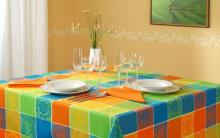
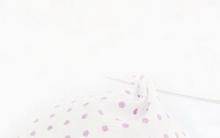
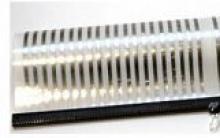
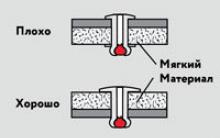
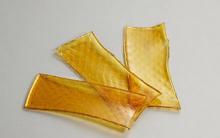
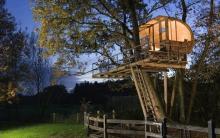




Home care for hippeastrum
Create a photo book online with your own hands
How to make a New Year's wreath on the door with your own hands New Year's wreath from a foam blank
Drip irrigation for a summer residence
How to sharpen kitchen knives correctly - instructions for use How to sharpen a knife on a whetstone